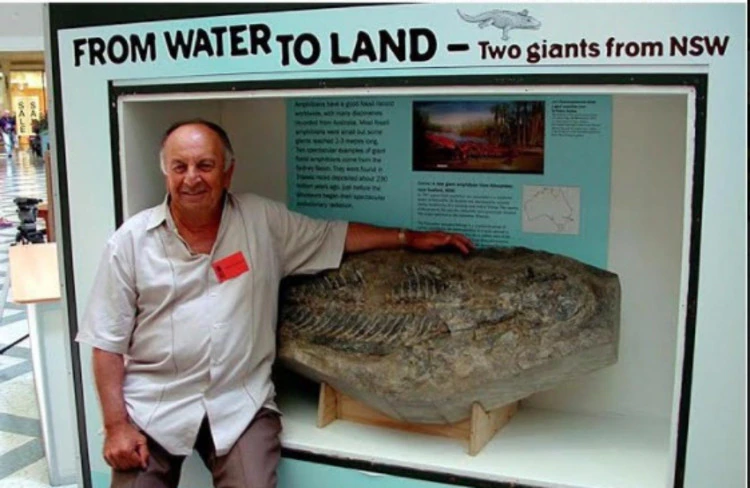Ancient mystery solved: Lizard-like creature found in retaining wall has ‘hart’

Lachlan Hart Has a long history with the fossil he recently helped name.
The 240-million-year-old fossil was found in the early 1990s by chicken farmer, Mihail Mihaildis, on the New South Wales Central Coast. Mihail had bought a 1.6-tonne sandstone slab to fix a broken retaining wall at his home but as he sliced through the stone’s outer layers, the outline of an unknown creature revealed itself. The Australian Museum’s (AM) former Head of Palaeontology, Dr Alex Ritchie, persuaded Mihail to donate the fossil to the museum, where it was included in a travelling dinosaur exhibition at Darling Harbour.
It was here that a young Lachlan saw the fossil, spoke to AM staff and decided to be a palaeontologist. Twenty-five years on, Lachlan, who holds joint roles with the Australian Museum and UNSW Science, is doing his PhD on this very fossil, and has just had his first paper published.
“I was obsessed with dinosaurs… and so 12-year-old me saw that fossil on display back in 1997. And then 25 years later it became part of my PhD, which is insane,” Lachlan says.

The fossil, named Arenaepeton supinatus, meaning ‘supine sand creeper’ – shows nearly the entire skeleton, and remarkably, the outlines of its skin. Less than 10 fossils of the lizard-like species have been identified globally. And Lachlan says the discovery may “rewrite the evolution of amphibians in Australia”.
“This fossil is a unique example of a group of extinct animals known as temnospondyls, which lived before and during the time of the dinosaurs,” says Lachlan.
“It’s got the head and the body attached, and the fossilisation of the creature’s skin and fatty tissues around the outside of its body – all of that makes this a really rare find.”
Arenaerpeton inhabited freshwater rivers in what is now known as the Sydney Basin during the Triassic period, 240 million years ago. Lachlan says it most likely hunted other ancient fish such as Cleithrolepis, but apart from that, there is not much evidence that tells us about the other animals which shared the land and waters with Arenaepeton.

“Superficially, Arenaerpeton looks a lot like the modern Chinese giant salamander, especially in the shape of its head,” Lachlan says.
“However, from the size of the ribs and the soft tissue outline preserved on the fossil we can see that it was considerably more heavyset than its living descendants. It also had some pretty gnarly teeth, including a pair of fang-like tusks on the roof of its mouth.”
Lachlan says what is exciting about the discovery is that Arenaerpeton is large – estimated to be about 1.2m from head to tail – when most other closely related animals that lived at the same time were small.
“The last of the temnospondyls were in Australia 120 million years after Arenaerpeton, and some grew to massive sizes. The fossil record of temnospondyls spans across two mass extinction events, so perhaps this evolution of increased size aided in their longevity.”

Dr Matthew McCurry, Curator of Palaeontology at the Australian Museum and Senior Lecturer in UNSW’s School of BEES said the fossil is a significant find in Australian paleo history.
“This is one of the most important fossils found in NSW in the past 30 years, so it is exciting to formally describe it,” says Matthew, who is also a co-author on the study. “It represents a key part of Australia’s fossil heritage.”
The study has been published in the Journal of Vertebrate Paleontology, and the fossil will be on display at the Australian Museum, Sydney, later this year.






